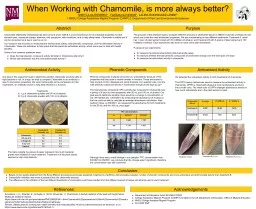

Antioxidant Activity References Conclusion Chamomile Matricaria c hamomila has been around since 1550 BC and is best known for its medicinal properties to treat stomach pain menstrual cramps diarrhea cold symptoms skin conditions and to help sleep better Chamomile is edibl ID: 1000000
Download Presentation The PPT/PDF document "Antimicrobial Activity Phenolic Compound..." is the property of its rightful owner. Permission is granted to download and print the materials on this web site for personal, non-commercial use only, and to display it on your personal computer provided you do not modify the materials and that you retain all copyright notices contained in the materials. By downloading content from our website, you accept the terms of this agreement.
1. Antimicrobial ActivityPhenolic Compounds Antioxidant Activity References:Conclusion: Chamomile (Matricaria chamomila) has been around since 1550 B.C and is best known for its medicinal properties to treat stomach pain, menstrual cramps, diarrhea, cold symptoms, skin conditions, and to help sleep better. Chamomile is edible and it can be consumed as a tea or used as an oil. Our research was focused on measuring the antimicrobial activity, total phenolic compounds, and the antioxidant activity in Chamomile. These are indicators to help prove that this plant has antioxidant activity, which are known to help with health benefits. Some of our research questions were:Does the total phenolic compound activity diminish in Chamomile after time?Which plant treatment has the most antimicrobial activity?Treatment ADiameter cmTreatment B Diameter cm Chamomile 1.31.21.25 mg C.B 1.92.02.5 mg C.B2.22.55 mg C.B 2.92.6Ethanol 1.41.0Phenolic compounds in plants are known as “antioxidants” because of the properties that they pose to health benefits in humans. These are known to help prevent chronic diseases and some illnesses. Our question was, Can the total phenolic compound activity in Chamomile change as the days go by?The total phenolic compound (TPC) activity was measured in Chamomile over a period of 6 days for both treatments with 50 mL and 100 mL of alcohol. Our goal was to determine whether there would be a change in concentration, or not. We started day 1 (6/3/2021) by measuring the absorbance of 3 tubes so that we could be able to calculate an average absorbance calculation. After waiting 6 days, on 6/9/2021, we measured the absorbance for both treatments for the 50 mL and the 100 mL once again.Although there was a small change in our samples’ TPC concentration from 6/3/2021 to 6/9/2021, we conclude that the change wasn’t significant, therefore the concentration was still conserved. mL06/03/2106/09/21501.9421.1271001.7191.517Treatments: A: 1 g of chamomile powder with 50 ml of ethanol. B: 5 g of chamomile powder with 100 ml of ethanol. ABChamomile 100 μLAverage 1st DPPH %2nd DPPH %Treatment A0.05726.0376.79Treatment B0.02410.923.21Based on the results obtained from the three different procedures previously explained, treatment A (1g/50mL) demonstrates a greater number of phenolic compounds and more antioxidant and antimicrobial activity than treatment B. Carbenicillin inhibition was more successful than the chamomile extracts. The difference in the inhibition of the two different treatments of chamomile could have resulted from the different amount of tissue and ethanol used in each treatment. We detected the antioxidant activity in both treatments of chamomile. The DPPH assay method was used to measure the antioxidant activity in chamomile. DPPH is mixed with ethanol at room temperature and turns into a violet color. The violet color of DPPH changes absorbance based on how much antioxidants are in the plant extract is used. Department of Education Grant #S1494A170003College Assistance Migrant Program (CAMP) is funded by the US Department of Education, Office of Migrant Education.NMSU College Assistant Migrant Program All CAMP Staff Our goal in this experiment was to determine whether chamomile would be able to fight bacteria or not. In a way, we tried to compare Chamomile to an antibiotic to see if it had similar properties. We used Carbenicillin as the comparison for this experiment, an antibiotic known to help treat infections in humans. Srivastava, J. K., Shankar, E., & Gupta, S. (2010, November 1). Chamomile: A herbal medicine of the past with bright future. Molecular medicine reports. https://www.ncbi.nlm.nih.gov/pmc/articles/PMC2995283/#:~:text=Chamomile%20preparations%20are%20commonly%20used,extensively%20in%20cosmetics%20and%20aromatherapy. Review: dietary phenolic compounds, health benefits and bioaccessibility. Archivos Latinoamericanos de Nutrición. (n.d.). https://www.alanrevista.org/ediciones/2016/2/art-1/. TPC ConcentrationThe halos outside the pieces of paper represent how much bacterial growth was inhibited on each treatment. Treatment A of the plant extract seemed to stop more bacteria. AbstractAcknowledgementsPurposeWhen Working with Chamomile, is more always better?SHEYLA GUTIERREZ¹ , FATIMA OLIVEROS¹, LAURA RODRIGUEZ-URIBE²NMSU College Assistance Migrant Program (CAMP) 2. Department of Plant and Environmental Sciences The purpose of this research was to compare different amounts of chamomile tissue in different volumes of ethanol to see which one holds the most antioxidant properties. We are concentrating on two different treatments, Treatment A, which has 1 gram of plant extract mixed with 50 milliliters of ethanol, and Treatment B with 5 grams of plant extract and 100 milliliters of ethanol. Each experiment was done on each of the plant treatments.Purpose of our experiments:To measure the antimicrobial activity that chamomile posesTo measure whether the total phenolic compounds of chamomile change over the time span of 6 daysTo measure the antioxidant activity in chamomileNegative controlTreatment B (10 uL)Treatment A (10 uL)